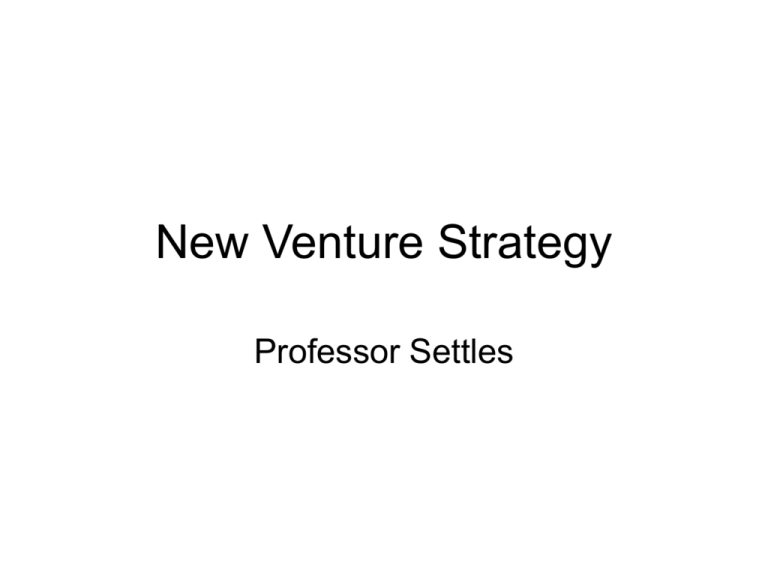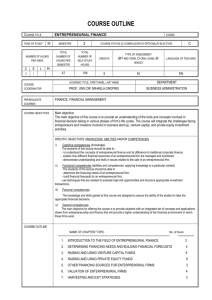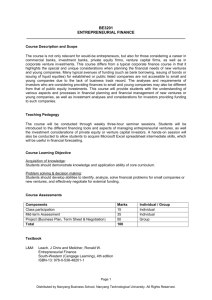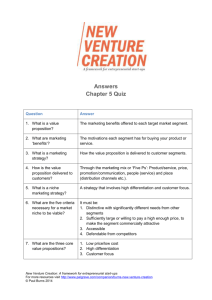New Venture Strategy
advertisement

New Venture Strategy Professor Settles Course Update • No lecture on Friday November 27th • Exam on December 4th • Review of Literature / Research Paper due December 11th Learning Objectives – – – – The role of opportunities, resources, and entrepreneurs in successfully pursuing new ventures. The role of new ventures and small businesses in the U.S. economy. Three types of entry strategies—pioneering, initiative, and adaptive—commonly used to launch a new venture. How the generic strategies of overall cost leadership, differentiation, and focus are used by new ventures and small businesses. Learning Objectives – How competitive actions, such as the entry of new competitors into a marketplace, may launch a cycle of actions and reactions among close competitors. – The components of competitive dynamics analysis—new competitive action , threat analysis, motivation and capability to respond, types of competitive actions, and likelihood of competitive reaction. Recognizing Entrepreneurial Opportunities • Entrepreneurship – new value creation • New value can be created in: – Start-up ventures – Major corporations – Family-owned businesses – Non-profit organizations – Established institutions Opportunity Analysis Framework Adapted from Exhibit 8.2 Opportunity Analysis Framework Sources: Based on J. A. Timmons and S. Spinelli, New Venture Creation, 6th ed. (Burr Ridge, IL: McGraw-Hill/Irwin, 2004); and W. D. Bygrave, “The Entrepreneurial Process,” in W. D. Bygrave, ed., The Portable MBA in Entrepreneurship, 2nd ed. (New York:Wiley, 1997). Question What is the starting point for any new business venture? A) The resources to pursue the opportunity B) The presence of an entrepreneurial opportunity C) An entrepreneur or entrepreneurial team willing and able to undertake a social responsibility D) The creation of a business concept Entrepreneurial Opportunities • Opportunities come from many sources – Start-ups • Current or past work experiences • Hobbies that grow into businesses or lead to inventions • Suggestions by friends or family • Chance events • Change Entrepreneurial Opportunities • Opportunities come from many sources – Established firms • Needs of existing customers • Suggestions by suppliers • Technological developments that lead to new advances • Change Entrepreneurial Opportunities • Discovery phase – Period when you first become aware of a new business concept – May be spontaneous and unexpected – May occur as the result of deliberate search for • New venture projects • Creative solutions to business problems Opportunity Recognition Process • Opportunity evaluation phase – Evaluating an opportunity (Can it be developed into a full-fledged new venture?) • Talk to potential target customers • Discuss it with production or logistics managers • Conduct feasibility analysis – – – – Market potential Product concept testing Focus groups Trial runs with end users Characteristics of Good Opportunities Good Business Opportunity Attractive Achievable Value creating Durable Before launching opportunity as a business •Consider the resources available to undertake it •Consider the characteristics of the entrepreneur pursuing it Entrepreneurial Leadership • Launching a new venture requires a special kind of leadership – Courage – Belief in one’s convictions – Energy to work hard • Three characteristics – Vision – Dedication and drive – Commitment to excellence Entrepreneurial Leadership • Vision may be entrepreneur’s most important asset – Ability to envision realities that do not yet exist – Exercise a kind of transformational leadership – Able to share with others Entrepreneurial Leadership • Dedication and drive are reflected in hard work – Patience – Stamina – Willingness to work long hours – Internal motivation – Intellectual commitment to the enterprise – Strong enthusiasm for work and life Entrepreneurial Leadership • To achieve excellence, venture founders and small business owners must – Understand the customer – Provide quality products and services – Pay attention to details – Continuously learn – Surround themselves with good people Entrepreneurial Strategy • Best strategy for the enterprise will be determined to some extent by – A viable opportunity, resources, and entrepreneur – Other conditions in the business environment • Can use various tools and techniques to determine strategic choices – Five Forces analysis – Value chain analysis Entry Strategies • Getting a foothold in the market – Pioneering new entry • Creating new ways to solve old problems • Meeting customer’s needs in a unique new way – Imitative new entry • Strong marketing orientation • Introduce same basic product or service in another segment of the market Entry Strategies • Getting a foothold in the market – Adaptive new entry • Offer product or service that is “somewhat new and different” • Aware of marketplace conditions and conceive entry strategies to capitalized on current trends Generic Strategies • How new ventures can achieve competitive advantages – Overall cost leadership • Simple organizational structures • More quickly upgrade technology and integrate feedback from the marketplace • Make timely decisions that affect cost – Differentiation • Use new technology • Deploy resources in a radical new way – Focus • Niche strategies fit the small business mold Combination Strategies • A key issue is the scope of a small firm’s strategic efforts relative to those of its competitors – Pursue combination strategies • Combine best features of low-cost, differentiation, and focus strategies • Flexibility and quick decision-making ability of a small firm not laden with layers of bureaucracy Model of Competitive Dynamics Sources: Adapted from Chen, M-J. 1996. Competitor analysis and interfirm rivalry: Toward a theoretical integration. Academy of Management Review, 21(1): 100-134; Ketchen, D.J., Snow, C. C., Hoover, V.L. 2004. Research on competitive dynamics: Recent accomplishments and future challenges. Journal of Management, 30(6): 779-804; and Smith, K.G., Ferrier, W.J., & Grimm, C.M. 2001. King of the hill: Dethroning the industry leader. Academy of Management Executive, 15(2): 59-70. Strategic and Tactical Competitive Actions Actions Strategic Actions • • • • Entering new markets New product introductions Changing production capacity Mergers/Alliances Tactical Actions • • • • Price cutting (or increases) Product/service enhancements Increased marketing efforts New distribution channels Likelihood of Competitive Reaction • How a competitor is likely to respond will depend on three factors – Market dependence – Competitor’s resources – The reputation of the firm that initiates the action (actor’s reputation) Crafting • Create a simple intuitive approach that facilitates crafting a creative idea into a unique and definitive new venture strategy • • • This approach is designed to achieve two objectives: Incorporate relevant academic knowledge at the right time and place to compliment the entrepreneur’s intuitive insight Facilitate insight into the alternate opportunities and strategies inherent in the entrepreneur’s creative vision Strategy Design Considerations A natural and intuitive process that synthesizes: - Creativity – the entrepreneur’s tacit intuition and insight - Knowledge – The explicit and relevant academic knowledge Strategy Models • • • • Mintzberg’s theory of strategy crafting Eisenhardt’s strategy as simple rules Janis’s vigilant problem solving Kaplin & Norton’s strategy maps A three-phase strategy crafting approach A three-phase strategy crafting approach focused on three critical decisions encountered in the art of strategy crafting: 1. Envision the range of opportunities 2. Assess the feasibility of opportunities 3. Craft the new venture strategy Entrepreneurial Strategy Crafting Approach Approach Phase Prerequisite Requirement The creative idea Phase I - Envision the Opportunities Key Activities Involved 1. Create the idea 2. Identify a basic vision or future state 1. Envision a range of alternative business products or services Envision the range of 2. potential business applications and target 3. markets inherent within the creative idea Envision a range of alternative target markets Identify potential ApplicationTarget Paths, i.e., “The Opportunities” inherent in the creative idea Phase II Assess Feasibility 1. Create intuitive, simple rules-based feasibility decision criteria 2. Assess each identified opportunity as to its potential feasibility/credibility 3. Identify key characteristics of the feasible “Proto-strategies” Phase III Craft the Strategy 1. Configure each proto-strategy to its natural type and natural basis Comparatively evaluate the Strategies using entrepreneurial insight 2. Evaluate each configured proto-strategy using entrepreneurial insight and the relevant academic knowledge for its specific configuration 3. Comparatively examine the protostrategies to determine the best entrepreneurial strategy Assess the perceived feasibility of the envisioned opportunities and determine the defining characteristics Strategy Crafting Outcome A Crafted Strategy A unique and distinctive entrepreneurial strategy for the new venture Feasibility Assessment: Simple Decision Rules • Competencies available versus competencies required – Intellectual competencies – tacit, explicit, patents and copyrights – Technological, operational, marketing, or development competencies • Consideration of the value of boundary rules - determine what limits the opportunity – Market, environment, competitors, regulations, technology, capital? – The level of uncertainty, the lack of critical resources Feasibility Assessment: Simple Decision Rules • Consideration of the value of resource rules: – – – • Understand the critical resources required The Ability to develop or acquire the critical resources Proven Competency with resources required Consideration of the value of timing rules: – – – Perceived window of opportunity for the new venture Perceived startup and development time Expected market and product life cycles Strategy Defining Characteristics • The unique feature that serves to differentiate the opportunity • The products and services to best exploit the opportunity: – Derived product/service lines – Potential for developing future core competencies • The target markets perceived available for exploitation: – Ability to competitively position the venture in an existing market – Ability to use the venture to expand the existing market – Ability to use the venture to create a new market Strategy Defining Characteristics • Consider the types of critical resources required : – Knowledge-based resources: patents, copyrights, proprietary – Technology-based resources: leader technology, follower technology – R&D-based resources, facilities and support – Capital-based resources: finance, facilities, materials • Consider the type of competitive advantage to be pursued: – Cost Leadership strategy – the low cost competitor – Differentiation strategy – unique hard to imitate products/services – Niche strategy – a subset of cost leadership or differentiation • Consider what is the basis for competitive strategy: – Market Based – external orientated strategy – Resource Based – internal orientated strategy Strategy Defining Characteristics • Consider how the excess return is to be achieved/sustained: – Superior price/quality performance – Continuous value added innovation – Achieving and maintaining an economy of scale – Superior customer service/loyalty – Patent or copyright protection – Superior research and development technology Strategy Types A - Low cost–market based strategy B - low cost–resource based strategy C - differentiation–market based strategy D - differentiation–resource based Strategy • • Evolutionary Revolutionary Strategy Types 1. 2. “Cost-leadership” Strategy - to become the low-cost product /service provider “Differentiation” Strategy - to provide a unique value-added product/service Cost-Leadership Type Strategy • The Cost Leadership Strategy is based on achieving a sustainable low cost competitive advantage • Cost leadership usually entails economy of scale – a high volume approach based on: – – – – low cost products and services low cost operation processes low cost distribution chains low cost materials • Cost leadership can also be proprietary – based on patents or copyrights • Cost leadership can also be niche based – low cost for a narrow product or market segment Differentiation Type Strategy • The Differentiation Objective is to achieve a sustainable competitive advantage based on unique products or services • Differentiation strategy is typically based on: – – – – Intellectual knowledge Unique experience Innovative approaches Technological advances • Differentiation offers customer’s unique value-added attributes clearly perceived to be superior to the competition • Differentiation requires continuous innovation to sustain competitive advantage –investments in research and talent • Differentiation strategy allows premium pricing for unique value-added features Second Dimension of Strategy • “Market Based” Strategy – external-orientated approach with the market dominant • “Resource Based” Strategy – internal-oriented where the resources are dominant A Market Based Strategy • The existing market determines the strategy • Strategy is primarily dependent on the selected market and its industry forces – – – – The strategy is limited to one market The market is selected for attractiveness to the creative idea The goal is to achieve a sustainable competitive position The strategy objective is to influence the market so as to improve the new venture’s competitive position • Market based strategy is a competition driven zero sum game • This strategy is best employed in relatively stable market environments A Resource Based Strategy • The new venture’s resources determine the strategy • Strategy is based on the new venture’s internal resources and competencies – Resource-based strategy facilitates reactions to market changes – A competency driven resource strategy can more quickly react to or even create change • Resource-based strategy can cross markets and industries • Best employed in environments of rapid market or technology change Strategy Differentiation • • • • Cost Leadership–market based strategy Cost Leadership–resource based strategy Differentiation–market based Differentiation–resource based – Evolve the market – Create the market Differentiation - Resource Based Type Evolutionary Approach • Goal – “Exploit, do not disrupt the markets”. • Utilize the new venture’s tangible and intangible internal resources • Generate sustainable value-added products and services that are difficult to imitate • Continually expand an established market, or multiple markets, avoiding wholesale disruption • Develop tangible and intangible internal resources into core competencies • Produce a range of products and services for various markets that are superior in customer value and difficult to imitate. Evolutionary – Resource based differentiation strategy Prerequisite Requirements • Intellectual Capital: the ability to outthink the competition • Conversion Capability: the ability to convert intangible assets into resources • Core Competency Base: the ability to develop a “right” set of core competencies Intellectual Capital Required • Identify and develop the basic core competencies • Goal is to continuously create diverse lines of unique products or services with differentiating attributes that that add customer value superior the competitors across multiple markets. • The differentiating attributes could include: – – – – – – Improved performance Additional/alternative capabilities Expanded life Increased reliability Aesthetic appeal Environmental or safety factors Conversion Capability • Ability to convert intangible intellectual assets into critical tangible resources and future core competencies • The new venture begins with limited resources, mostly intangible. • A key strategy consideration is how to convert limited resources, intangible ideas, and visions into: – – – – Tangible capabilities Core competencies, Strategic assets and finally, a sustainable competitive advantage. • This entrepreneurial conversion process requires; – Identification of the critical resources required for success – A method of gaining access to the critical resources – Combining the critical resources with the required competencies Other Relevant Strategy Considerations • The evolutionary resource-based differentiation strategy allows • Increased flexibility – Exploit the creative vision across the spectrum of products and services in multiple markets – Rapid adjustment to continuous or dramatic changes in key environmental or market conditions • Mitigated risk and uncertainty – Multiple market dispersion reduces single market risk – Avoidance of major market disruption reduces risk • The value of multiple markets – Creating new products in multiple markets allows the ability to seek premium pricing in multiple markets Other Relevant Strategy Considerations • Operating in multiple markets incurs the risk of dissipating the new venture’s resources and efforts resulting in a potential lack of strategic focus. • Consider the impact of potential technological change – What potential technological changes could significantly impact on the new venture’s resource based differentiation strategy and when? • Consider the impact of globalization driven change – What potential globalization factors could significantly impact on the new venture’s resource based - differentiation strategy and when? Business Model • Is an outline of the actions that occur in the delivery of a good or service • The plan for how a firm – – – – – Competes (core strategy), Uses resources (distinctive resources), Structures relationships (partnership network), Interfaces with customers (customer interface), and Creates value to sustain itself based on its generated profits (approach to creating value) • A firm’s business model takes it beyond its boundaries (to consider necessary partners that help enable the business model) Dell’s vs. IBM Business Model How Business Models Emerge • The Value Chain – Illustrates activities that move products from raw material stage - manufacturing and distribution - end user. – Studying a business or industry’s value chain, can help identify opportunities for new businesses – That is, areas in the value chain where value can be created How Business Models Emerge • Using the Value Chain – Examine business or industry value chains to see where additional “value” can be added (e.g., can be more effective) and focus firm around creating this new value • Analysis may focus on: – One primary activity (e.g., marketing and sales) » FedEx, UPS with Outbound Logistics – One support activity (e.g., human resource management) » Administaff & Paychex with HRM; Accenture and BCG with Management Support (e.g., administration) – Interface between ≥ 2 stages (e.g., operations & outbound logistics) » DHL, UPS with operations (supply and distribution management) and outbound logistics (shipping offerings to consumers) Fatal Flaws To Avoid in Business Models • Fatal Flaws • Two fatal flaws can render a business model untenable from the beginning: – A complete misread of the customer – Utterly unsound economics Four Components of a Business Model Business Model Component 1: Core Strategy • Core Strategy: how firm competes relative to competitors – Porter’s generic strategies • Cost leadership: operations streamlined for efficiency (e.g., Wal-Mart) • Differentiation: create an industry-wide perception of unique value (e.g., Tiffany jewelry; Intel) • Focus: concentrate on narrow segment of the industry (e.g., Red Bull with energy drinks) of a narrow set of customers (e.g., Babies ‘R’ Us with baby needs) • Focused-differentiation: uniquely serve narrow industry or customer segments (e.g., Babies ‘R’ Us comprehensively serves consumers in need of baby care items) Business Model Component 1: Core Strategy • Requires development of Business mission (overarching purpose): describes why firm exists and what it’s supposed to accomplish – Southwest: “…the highest level of customer service delivered with… warmth, friendliness, individual pride, and company spirit.” – Product/market scope (what you provide customers): defines products & markets on which firm concentrates – Amazon: adjusted product choices over time (first only books - cds, dvds, etc.) Business Model Component 2: Strategic Resources • Strategic Resources – The resources firm has substantially affects business model • New ventures’ resources often limited to competencies of founders, opportunity identified, unique way they serve the market – 2 most important strategic resources are: • Core competencies: resource/capability serves as source of competitive advantage over rivals – When identifying core competencies, try to identify skills that are unique, valuable to customers, difficult to imitate, and transferable to other opportunities – Examples: Sony and miniaturization, Dell’s supply chain management • Strategic assets: anything rare and valuable that firm owns – Brands, patents, customer data, distinctive partnerships, HR, etc. – Example: Starbucks’ brand name in coffee retailing Business Model Component 2: The Importance of Strategic Resources • Must combine core competencies & strategic assets to get a sustainable competitive advantage • Investors pay attention to this when evaluating a business • A sustainable competitive advantage is achieved by having Valuable, Rare, and Inimitable strategic resources that the founder has the ability to use (e.g., can Organize/implement them effectively). – Value: Does a resource enable a firm to exploit an environmental opportunity, and/or neutralize an environmental threat? – Rarity: Is a resource currently controlled by only a small number of competing firms? [are the resources used to make the products/services or the products/ services themselves rare?] – Imitability: Do firms without a resource face a cost disadvantage in obtaining or developing it? [is what a firm is doing difficult to imitate?] – Organization: Are a firm’s other policies and procedures organized to support the exploitation of its valuable, rare, and costly-to-imitate resources?” Business Model Component 3: Partnership Network • New ventures don’t usually have all resources needed to perform all activities • Do not want to do everything as many tasks aren’t core to venture’ competitive advantage – Example: Nike with manufacturing – Example: Dell with suppliers (e.g., Intel supplies microprocessors to Dell, gets paid quickly, uses Dell’s supply management software, etc.) • It’s important to have collaborative relationships with suppliers, and to find ways to motivate them to perform at higher levels Business Model Component 3: Common Types of Business Partnerships • Joint Venture: Formal partnership (involves equity stakes) – Two or more firms pool resources to create a separate, jointly owned organization (e.g., Sony Ericsson to make mobile phones using Sony’s consumer electronics and Ericsson’s technology leadership expertise) • Strategic Alliance: Generally no equity, but contractual in nature – Relationship between two or more firms that exchange resource with one another but do not have a joint, equity, relationship (e.g., Lexus and Coach Limited Lexus ES 300 Coach Edition) • Trade Associations: Informal partnership (often non-profit) – Organizations formed by firms to collect and disseminate important industry information – Often used to promote the industry via advertising, lobbying, etc. • National Cattleman’s Association and “Beef, it’s what’s for dinner” campaign Business Model Component 4: Customer Interface • Customer Interface – The way a firm interacts with customers dictates how it competes • Ex. 1: Amazon.com sells on Internet; Barnes & Noble sells via traditional bookstores and online • Ex. 2: Dell initially sold only online; HP sells through retail stores – 3 elements of a ventures’ customer interface: • Target customer: people the firm tries to appeal to – Affects almost every decision the firm makes like strategic assets acquired, partnerships, promotional campaigns • Fulfillment & Support: How offerings get to customers and how they offer after-sale support – Fulfillment: Cell phone technology (license, manufacture, partner); Nike (outsources production, and focuses on marketing) – Support: Dell offers 24/7 support & customers pay more because it adds value • Pricing model: The cost of the venture’s offerings and how collect those funds – Ex. 1: Price leaders like Wal-Mart and Domino’s – Ex. 2: Create a new pricing strategy like Priceline.com Business Model Component 4: Customer Interface • Customer Interface – The way a firm interacts with customers dictates how it competes • Ex. 1: Amazon.com sells on Internet; Barnes & Noble sells via traditional bookstores and online • Ex. 2: Dell initially sold only online; HP sells through retail stores – 3 elements of a ventures’ customer interface: • Target customer: people the firm tries to appeal to – Affects almost every decision the firm makes like strategic assets acquired, partnerships, promotional campaigns » Example: Abercrombie vs. Chico’s • Fulfillment & Support: How offerings get to customers and how they offer after-sale support – Fulfillment: Cell phone technology (license, manufacture, partner); Nike (outsources production, and focuses on marketing) – Support: Dell offers 24/7 support & customers pay more because it adds value • Pricing model: The cost of the venture’s offerings and how collect those funds – Ex. 1: Price leaders like Wal-Mart and Domino’s – Ex. 2: Create a new pricing strategy like Priceline.com and CarMax







